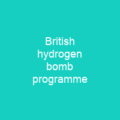Project Casaba-Howitzer was a 1960s-era study into the use of nuclear weapons as the drivers for intense beams of plasma for use in space warfare. The name comes from the casaba melon, a variety of honeydew. The concept got a second lease on life during the Strategic Defense Initiative in the 1980s.
About Casaba-Howitzer in brief

The design for Project Orion originally used small hydrogen bombs whose explosion ejecta was captured on a pusher plate, a large metal plate mounted on shock absorbers. A conventional hydrogen bomb includes two stages; the primary is an atomic bomb normally based on plutonium, while the secondary is a mixture of fusion fuel and various boosters.
You want to know more about Casaba-Howitzer?
This page is based on the article Casaba-Howitzer published in Wikipedia (as of Nov. 30, 2020) and was automatically summarized using artificial intelligence.







